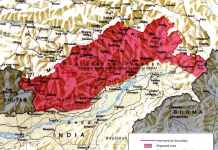The US Space Command faces imminent danger from its adversaries – Russia and China, who have developed state-of-art weaponry including jammers, ground-based lasers, ground & space-based kinetic weapons, attack ground facilities that support space operations.
Iran Used Advanced Russian Radars To Track ‘Stealth’ F-35 Jets; Has Missiles To Shoot It Down
In July, the US Space Command had accused Russia of conducting an anti-satellite test from one of its satellites in orbit. Russia’s testing of a weapon that the US says aims to destroy satellites attracted global criticism.
However, Russia downplayed the event. According to the Associated Press, the Kremlin said that the event involved – “a small space vehicle” that “inspected one of the national satellites from a close distance using special equipment.”
On the other hand, China, which is currently trailing behind Russia and the US is set to become a space power by 2030. China has been expanding its network of military intelligence satellites.
Last year, China conducted 32 successful rocket launches as per the Center for Strategic and International Studies, a Washington-based think tank. This puts China on top for the second year in a row, exceeding the 21 launches in the US in 2019.

The recently created US Space Force was reportedly needed in part due to Russian and Chinese anti-satellite weapons. In June, the Pentagon published a space strategy document saying that China and Russia present the greatest strategic threat due to their “development, testing, and deployment of counter-space capabilities and their associated military doctrine for employment in conflict extending to space.”
According to Army National Guard Major General Tim Lawson, the US has new capabilities to counter these threats from Russia and China. However, he couldn’t discuss them because they are classified under the umbrella of “black budget” projects.
“As a geographical combatant command focused on the space domain, those are the things that keep us up at night,” said Lawson, who made the remarks at the National Defense Industrial Association’s Space Warfighting Industry Forum, which was held virtually due to the Covid-19 pandemic.
“A lot of times you listen to that threat picture and you kind of get a little dismayed at what you’re seeing, but then you look at our side and — trust me — we’ve got some things coming. So, it’s good news.” Pentagon has raised the possibility of space-based sensors that can detect and track missile launches from nearly every location on the planet, as well as a missile interception system from space.
Lawson also highlighted the need to have space architectures that use large networks of small communications and intelligence-gathering satellites that would be less vulnerable to enemy attacks. “If you had hundreds of small satellites up there in a constellation … the enemy can take out quite a few of those and it will really never have an impact on us,” he said. “That really is the resiliency piece that we’re seeking out there and we need.”
US Space Force is also looking at developments in space logistics like in orbit refueling or satellite servicing. “If we could ever figure that out to where it is an economic way to do business, it would be a gamechanger, absolutely,” he said. “No doubt about it. And we would fully support a capability that would allow us to do that. And I think we would be very open to having some very good candid conversation on where the industry is at in that piece of it.”




